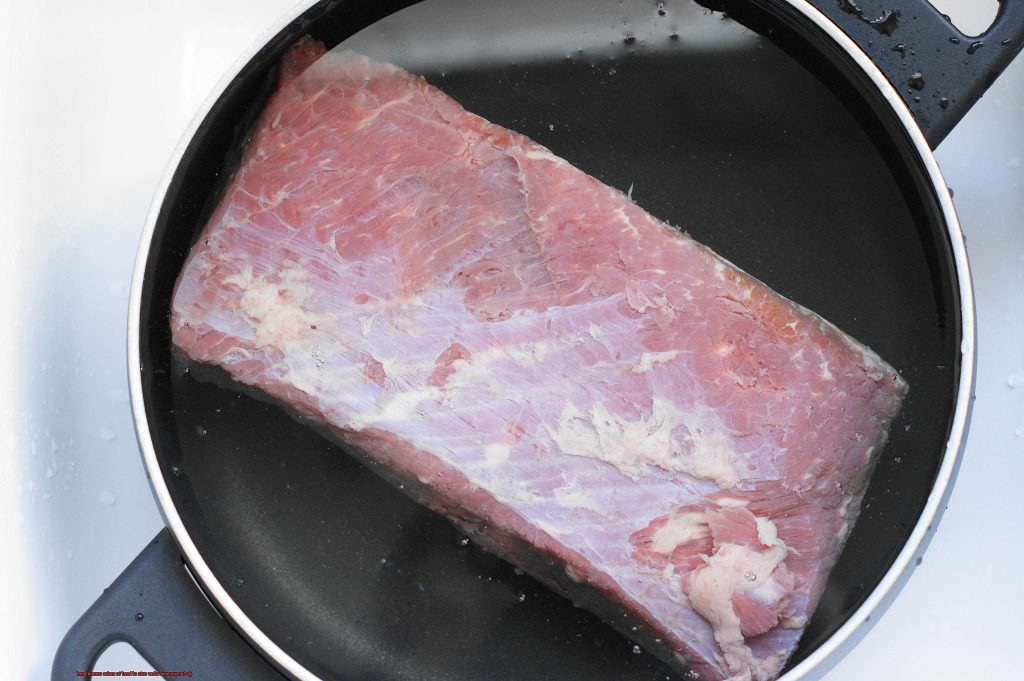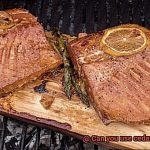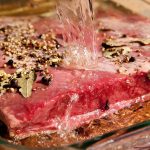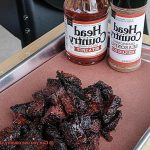Are you tired of the same old brisket for your St. Patrick’s Day corned beef? Or maybe you can’t find brisket at your local market? Fear not, because we’re here to explore the possibility of using other cuts of beef to make this beloved dish.
Let’s start with a little history lesson on corned beef and its association with St. Patrick’s Day. Then, we’ll dive into why brisket is the traditional choice and what makes it so popular. But don’t worry, we won’t stop there – we’ll also discuss alternative cuts like round and chuck, weighing the pros and cons of each.
And because we want your corned beef to be nothing short of amazing, we’ll provide tips on how to properly prepare and cook your chosen cut of beef. Plus, we’ve got some delicious recipe ideas up our sleeves, like slow-cooker pot roast style or cranberry-glazed corned beef.
So whether you’re a die-hard brisket fan or ready to mix things up this year, keep reading to find out if other cuts of beef can work for corned beef and how to make it happen.
Contents
What is Corned Beef?
Corned beef is a beloved and versatile dish that has been enjoyed for centuries. This salt-cured beef product is typically made from the brisket cut of beef, but did you know that other cuts can be used as well? Let’s dive into the origins of corned beef, its unique flavor, and the different cuts of beef that can be used to make it.
Origins of Corned Beef
Corned beef originated in Ireland, where it was a staple food for centuries. Irish immigrants brought their love of corned beef to America, where it became a popular dish, especially around St. Patrick’s Day. Today, corned beef is enjoyed all over the world and can be found in many different variations.
What is Corned Beef?
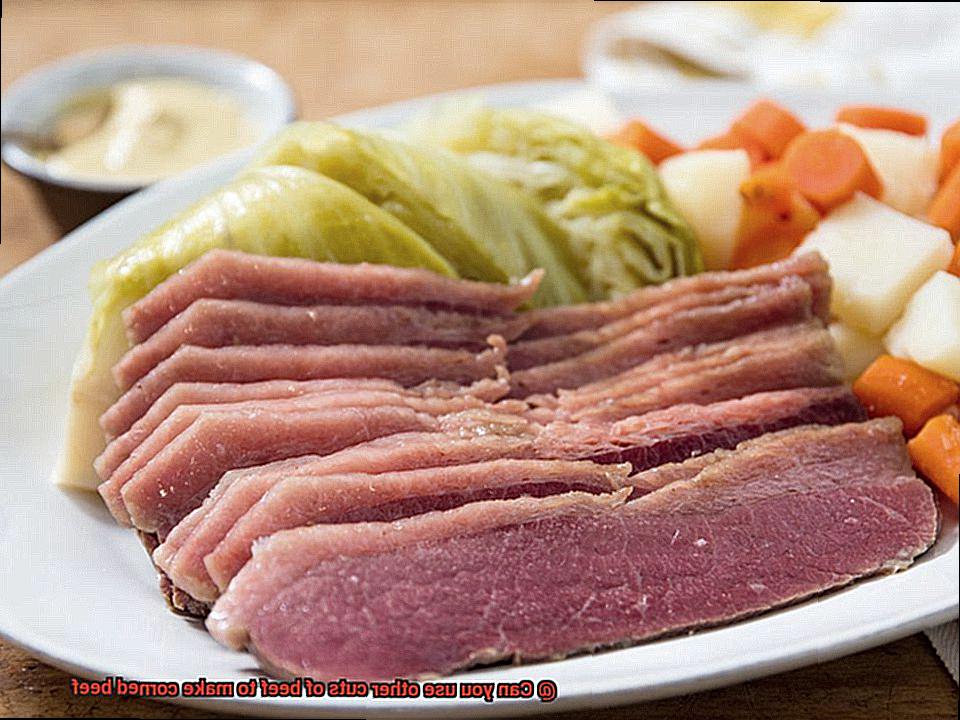
Corned beef gets its name from the large grains of rock salt used to cure the meat, giving it a distinct salty flavor. It is often used in sandwiches, stews, and other dishes because of its versatility. The curing process involves soaking the brisket cut of beef in a mixture of salt, sugar, and spices for several days. This process helps tenderize the meat and infuse it with flavor. After curing, the meat is boiled or simmered until it is tender and fully cooked.
Alternative Cuts of Beef for Corned Beef
While brisket is the most commonly used cut of beef for making corned beef, other cuts can also be used with great success. Here are some alternative cuts to consider:
- Round Roast: This cut comes from the hindquarters of the cow and is typically less fatty than brisket. While it may not be as tender as brisket, it can still produce a flavorful and delicious corned beef if prepared correctly.
- Chuck Roast: This cut comes from the shoulder of the cow and is typically more marbled than brisket. This extra fat content can help keep the meat moist and tender during the cooking process, resulting in a juicy and flavorful corned beef.
Traditional Cuts of Beef Used for Making Corned Beef
While brisket is undoubtedly a popular choice, there are other options that can make for a delicious meal.
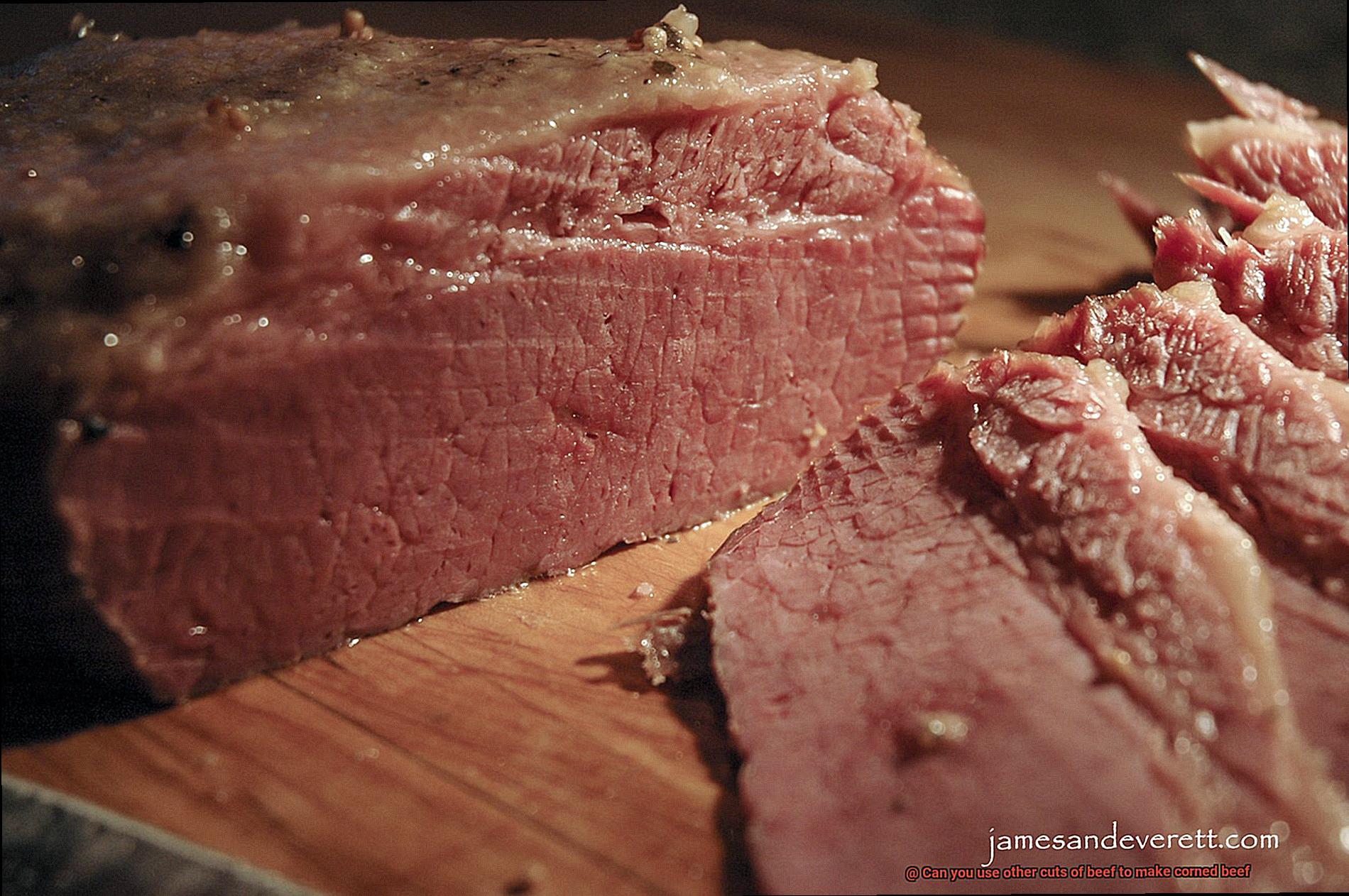
First up, we have the round roast. This cut comes from the hindquarters of the cow and is leaner than brisket. Round roast corned beef tends to be a bit tougher, but it still has a great flavor profile when cooked properly. So if you’re looking for a healthier option or want to switch things up, try using round roast for your next batch of corned beef.
Next on the list are the plate or flank steaks. These cuts come from the belly of the cow and have more fat than brisket or round roast. The higher fat content makes these cuts a bit more flavorful, but they require longer cooking times to become tender. So if you’re willing to put in some extra effort, these cuts can make for a mouthwatering meal.
Lastly, some people might opt for chuck roast as an alternative to brisket for corned beef. This cut comes from the front shoulder of the cow and has more marbling than round roast, making it more tender. However, chuck roast can have a stronger flavor than brisket or round roast, so it may not be ideal for those who prefer a milder taste.
Alternative Cuts of Beef for Making Corned Beef
While brisket may be the traditional go-to, there are other cuts that can make for a delicious and unique meal.
Let’s start with the round roast. This leaner cut comes from the rear end of the cow and can still be cooked to a tender and flavorful state. Marinating it for a longer period of time can help break down the tougher fibers and bring out its full potential.
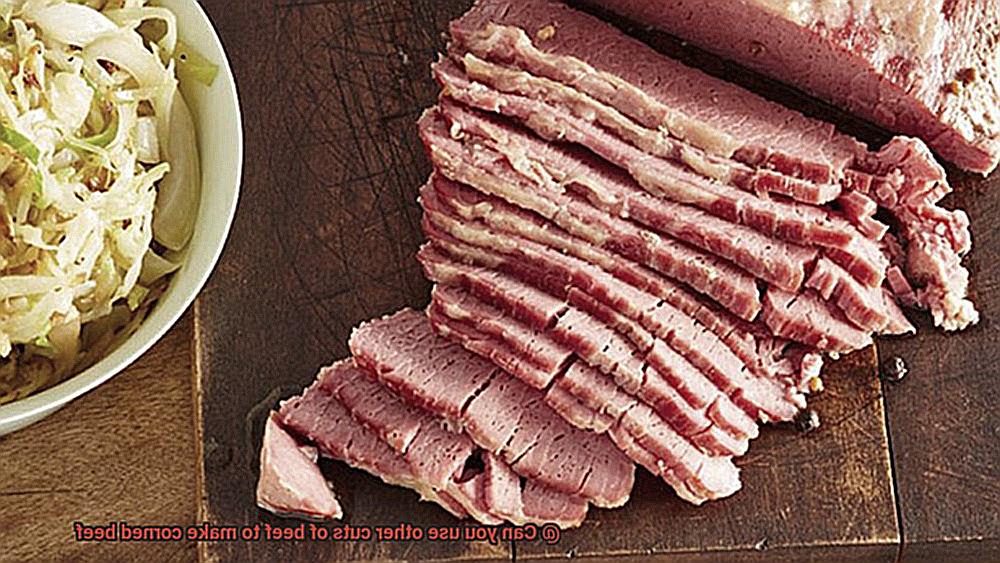
If you’re seeking more fat, the chuck roast is an excellent option. This cut comes from the shoulder of the cow and has more marbling than round roast, adding flavor and moisture to your corned beef. However, be sure to trim some of the excess fat before cooking to prevent it from becoming too greasy.
For something different, consider using sirloin tip roast. This tender and juicy cut from the lower part of the cow’s hindquarters may not be as traditional as brisket, but it can still make for a delightful corned beef dish.
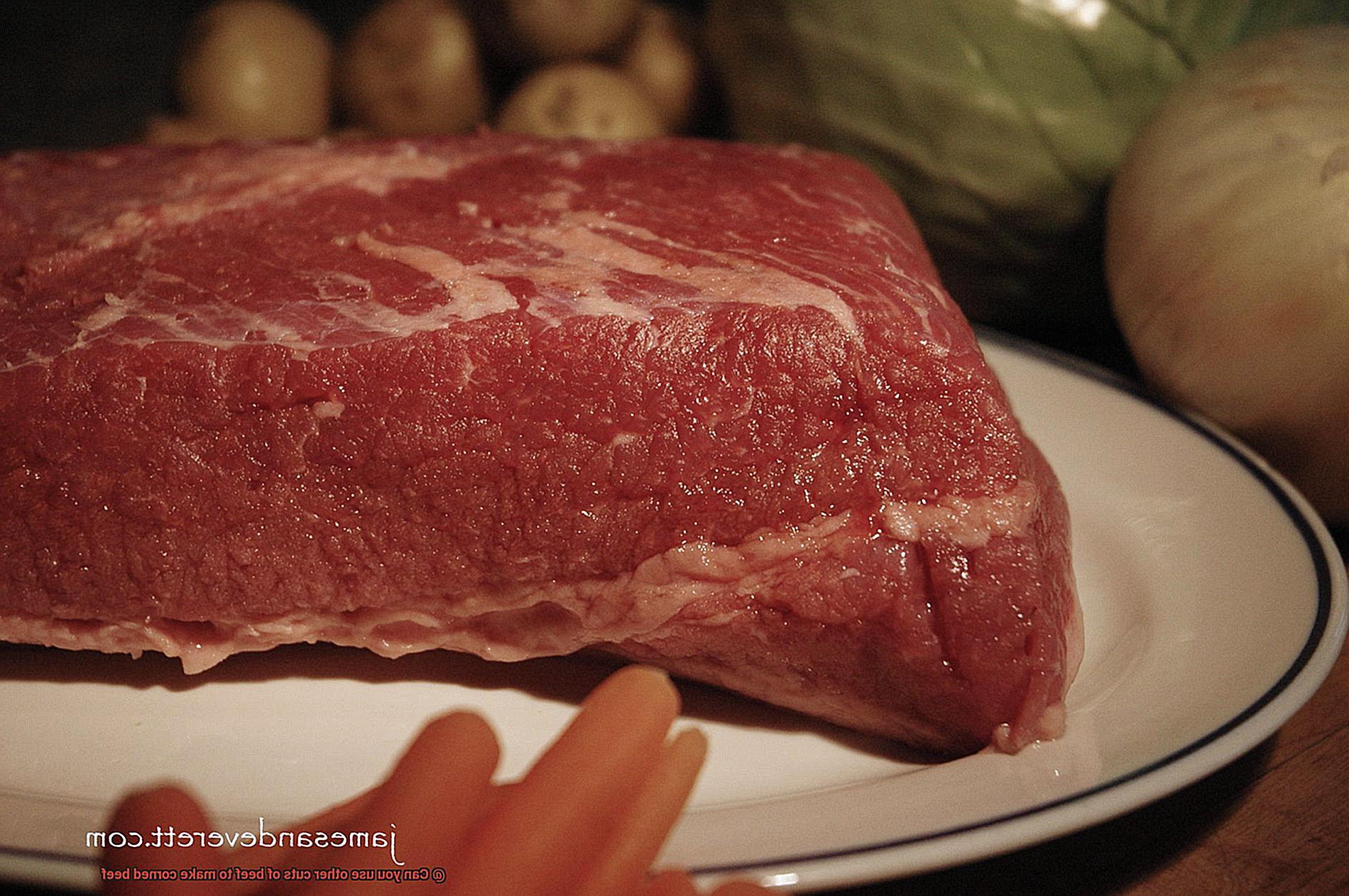
Keep in mind that alternative cuts may require different cooking times or methods compared to traditional brisket. But don’t let that intimidate you. With proper preparation and cooking techniques, these cuts can result in a flavorful and satisfying meal.
Round Roast: An Alternative Cut of Beef for Making Corned Beef
As an expert on this topic, I’ve delved into the research and discovered that round roast can be a leaner and less expensive option than other cuts of beef commonly used for this dish.
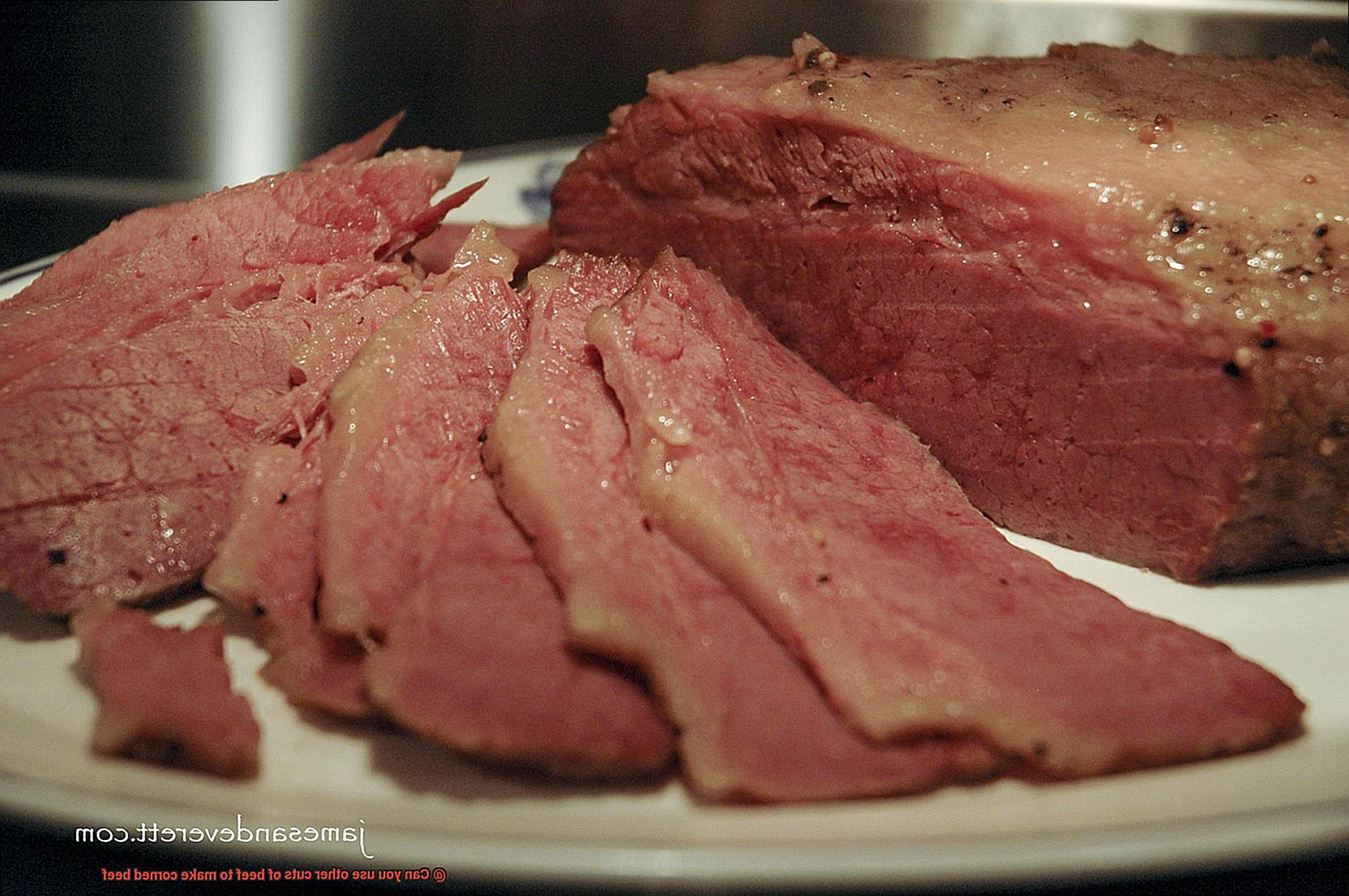
To make the perfect corned beef with round roast, it is crucial to follow a few important steps. Firstly, trim away any excess fat from the meat to ensure it is healthier and more tender. Next, soak the meat in a brine solution for several days, allowing the flavors to infuse and tenderize the meat.
Selecting the right cut of round roast is also vital in producing a delicious corned beef. Choose a well-marbled cut with a good amount of fat to keep the meat moist and flavorful during cooking.
One of the benefits of using round roast for corned beef is that it’s typically less expensive than other cuts of beef – great news for those on a budget. Additionally, it’s a healthier option since it’s leaner and contains less fat.
Chuck Roast: An Alternative Cut of Beef for Making Corned Beef
As a corned beef expert, I am thrilled to share with you why chuck roast is an excellent alternative cut for this classic dish.
Chuck roast comes from the cow’s shoulder area and boasts a rich, beefy flavor with marbling throughout that makes it tender and juicy when cooked correctly. Just like brisket, it can be cured in a mixture of salt, sugar, and spices to achieve that signature corned beef taste.
But what sets chuck roast apart is its forgiving nature when it comes to cooking times. Brisket can turn out dry and tough if overcooked, but chuck roast can withstand longer cooking times without losing its tenderness or moisture. This makes it an excellent choice for beginners or those looking for an easier cooking experience.
On top of its forgiving nature, chuck roast is often less expensive than brisket, making it a budget-friendly option for those who want to enjoy corned beef without breaking the bank. And unlike brisket, which may need to be special ordered at your grocery store, chuck roast is typically readily available.
Cooking Times and Techniques for Different Cuts of Beef
As an expert on this topic, I am excited to guide you through the process.
Traditionally, brisket is the cut of choice for corned beef, but don’t be afraid to switch things up with round or chuck roast. However, it’s essential to understand each cut’s distinct characteristics and adjust your cooking methods accordingly.
For example, round roast may require a longer cooking time than brisket, while chuck roast may need a higher temperature to become tender. Remember that the size and thickness of the cut can also affect cooking time.
To ensure safe consumption, use a meat thermometer and check that the internal temperature of the beef reaches at least 160 degrees Fahrenheit.
When it comes to cooking corned beef, slow and low is the way to go. Braising or slow roasting allows the meat to become tender and mouth-wateringly flavorful without becoming dry or tough.
In summary, here are some key points to keep in mind:
- Brisket is the traditional cut for corned beef, but other cuts like round or chuck roast can also be used.
- Adjust your cooking times and techniques based on the unique characteristics of each cut of beef.
- Use a meat thermometer to ensure that the internal temperature of the meat reaches 160 degrees Fahrenheit for safe consumption.
- Slow and low cooking methods like braising or slow roasting will yield the most delicious results.
Benefits of Using Different Cuts of Beef to Make Corned Beef
When it comes to making corned beef, many people default to using brisket, a cut of beef from the lower chest of the cow. But did you know that there are numerous benefits to using different cuts of beef in your corned beef recipe?
First and foremost, using different cuts opens up a world of flavors and textures that you may have never experienced before. For example, chuck roast or round roast can result in a more tender and juicy corned beef, while using tougher cuts like bottom round can provide a firmer texture and stronger beef flavor. The variety of options is practically endless.
But the advantages don’t stop there. Using different cuts can also be more cost-effective than using brisket, which tends to be on the pricier side. By opting for more affordable cuts like chuck or round, you can still achieve a delicious corned beef without breaking the bank.
In addition to being cost-effective, using different cuts can also be more sustainable. By utilizing all parts of the cow, including lesser-known cuts, it reduces waste and helps support small farmers who may not have access to the high-demand brisket cut. It’s a win-win situation for both your wallet and the environment.
Enhancing the Flavor of Your Corned Beef with Different Cuts of Meat
Traditionally, brisket is the go-to choice for making corned beef. However, using round instead can create a leaner yet still flavorful and tender dish. Don’t be afraid to take your time cooking the round cut at a lower temperature for best results.
Another option is chuck roast. This cut has more fat than brisket, but its rich flavor can enhance the taste of your corned beef. If you love juicy and succulent meat, chuck roast might be the perfect choice for you.
Want to really pack a punch in your corned beef? Consider using short ribs. They have a strong, meaty flavor that can add a unique twist to your dish. Braising them slowly over low heat can bring out all their delicious flavors and make for an unforgettable meal.
No matter which cut of beef you choose, it’s important to select high-quality meat with good marbling and avoid any excess fat or gristle. Keep in mind that different cuts may require different cooking methods and times.
hDITJT0NoQY” >
Conclusion
In conclusion, corned beef is a timeless classic that has stood the test of time. Although brisket is the traditional go-to cut for this dish, there are other cuts of beef that can be just as delicious. Round roast and chuck roast are great options that offer unique flavors and textures, while also being more sustainable and cost-effective.
When using different cuts of meat for your corned beef, it’s important to adjust your cooking methods accordingly. Slow and low techniques like braising or slow roasting work best to produce tender and flavorful results.
Quality meat is crucial when making corned beef, regardless of the cut you choose. Look for high marbling and avoid excess fat or gristle when selecting your meat.
Whether you’re a die-hard brisket fan or looking to switch things up this St. Patrick’s Day, there are plenty of options available for making mouthwatering corned beef.

